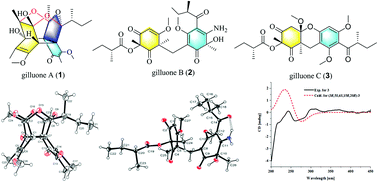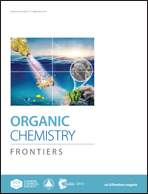Phloroglucinol heterodimers and bis-indolyl alkaloids from the sponge-derived fungus Aspergillus sp. SCSIO 41018†
Abstract
Gilluones A–C (1–3), three new phloroglucinol heterodimers, asterriquinones I–K (4–6), three new bis-indolylquinones, and asterriquinols G–I (7–9), three new bis-indolylbenzenoids, were isolated from the sponge-derived fungus Aspergillus sp. SCSIO 41018 together with five known bis-indolyl alkaloids (10–14). Their structures were determined by detailed spectroscopic analyses, X-ray diffraction, a modified Mosher's method and electronic circular dichroism analysis. Gilluone A (1) possessed an unprecedented heterodimer polyketide skeleton fused by intermolecular [4 + 2] Diels–Alder cycloaddition featuring a novel cage structure bearing ketal and hemiketal functionalities. Gilluone B (2) possessed a heterodimer acyl phloroglucinol featuring amino and ester groups. Compared with previous bis-indolylquinones, asterriquinone I (5) represented the first reported bis-indolylquinone possessing a chlorine atom. Asterriquinones I–K (4–6) displayed cytotoxic activities against K562, BEL-7042, SGC-7901, A549, and HeLa cell lines. A possible biosynthetic pathway for gilluones A–C (1–3) was proposed.



 Please wait while we load your content...
Please wait while we load your content...